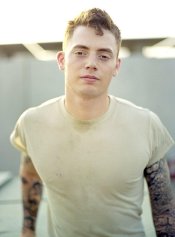First, thank you to all who have encouraged myself and others to develop at home. IT ACTUALLY WORKED FOR ME!!!
I did have some dificulties, looking for advice and/or specifically your methods during C-41 developing. Wait, I need to mention I used the dry chemical Tetenal kit from B&H for my developing process. NO additional chemicals were added during the process.
Let's start from the beginning. Loading the film into the Patterson Sytem 4 plastic reel. Used my nifty film leader tool to pull out the leader, snip it, trim corners and loaded 1 inch of film into the reel then put that will all the other garbage into the changing bag. Half way through I got the idea I probably should have taken the cartidge appart to aid in loading film. It didn't want to load into the reel until I did that AND cut the end off the spool. What is the proper way to do this AND should I have white gloves on?
Had all chemicals warmed up and in the garage (mainly because of possible smell issues decided to do out there first (was basically zero smell issues)) and being over 100 by noon certainly helped in maintaining temps. Pre warmed the tank by basically throwing in 500ml or so warm water to preheat, dumped, added developer......does it matter if I put 500ml in the tank that called for 350ml for one 35mm roll? It just seemed easier to simply dump half the 1 liter bottle I made into the tank then to measure out exactly the correct amount. Do I hurt anything by doing that? Or should I measure everything properly?
After I dumped the developer, I filled the tank with clear water for maybe 20 seconds, dumped then added the Blix. I did not know if what was left of the developer would screw up the Blix or not. Is this step necessary or am I wasting time? This recommendation to kind of rinse was based on a recommendation to me (although that was mainly B&W the recommendation to develope-rinse-stop bath....). Again, is a water stop bath (sort of) worth it, will the developer kill the Blix?
Of course after Blix I rinsed as directed with clear water and my patterson faucet rinse hose, that was money well spent, made washing very simple and error proof.
Then as directions did the stabilzer for 1 minute, dumped, grabbed my film clamp and started taking everything apart to get at my roll of Kodak Gold 200 film. When I pulled the film out of the reel, yes there were a few water spots. I did NOT add any photoflow to the stabilizer. I believe I read both way.....add it and no you are not supposed to add it.
I was going to use a film sponge wetted in photoflow water to squeeze the water off the film, but I noticed I had ordered a film squeegee and not a sponge, so I was to affaid to screw up the film and use the squeegee. So for now and the dry kit (I will be getting liquid chemical C-41 soon) how do I prevent water spots? Or what techniques do you use to prevent water spots.
Overall, I thought it wasn't bad for my first time developing. After 15 minutes of trying to figure out how to use my film scanner, the only adjustment I made in Lightroom was two clicks of darkening the exposure. Then everything printed pretty much as I normally do. They actually had a classic 60's feel on some of them which were mainly out door, the indoor ones looked right at what my Nikon D60 gives me.
So if anything, I think my negatives might be a little lighter than if I went and had them commercially developed, however, I was able to correct for it so I am pretty happy. I absolutely need to get a better monitor AND I need to calibrate the stupid thing and probably get and get one of those targes for my scanners.
Thanks for any help, ideas and suggestions,
Bob E.
I did have some dificulties, looking for advice and/or specifically your methods during C-41 developing. Wait, I need to mention I used the dry chemical Tetenal kit from B&H for my developing process. NO additional chemicals were added during the process.
Let's start from the beginning. Loading the film into the Patterson Sytem 4 plastic reel. Used my nifty film leader tool to pull out the leader, snip it, trim corners and loaded 1 inch of film into the reel then put that will all the other garbage into the changing bag. Half way through I got the idea I probably should have taken the cartidge appart to aid in loading film. It didn't want to load into the reel until I did that AND cut the end off the spool. What is the proper way to do this AND should I have white gloves on?
Had all chemicals warmed up and in the garage (mainly because of possible smell issues decided to do out there first (was basically zero smell issues)) and being over 100 by noon certainly helped in maintaining temps. Pre warmed the tank by basically throwing in 500ml or so warm water to preheat, dumped, added developer......does it matter if I put 500ml in the tank that called for 350ml for one 35mm roll? It just seemed easier to simply dump half the 1 liter bottle I made into the tank then to measure out exactly the correct amount. Do I hurt anything by doing that? Or should I measure everything properly?
After I dumped the developer, I filled the tank with clear water for maybe 20 seconds, dumped then added the Blix. I did not know if what was left of the developer would screw up the Blix or not. Is this step necessary or am I wasting time? This recommendation to kind of rinse was based on a recommendation to me (although that was mainly B&W the recommendation to develope-rinse-stop bath....). Again, is a water stop bath (sort of) worth it, will the developer kill the Blix?
Of course after Blix I rinsed as directed with clear water and my patterson faucet rinse hose, that was money well spent, made washing very simple and error proof.
Then as directions did the stabilzer for 1 minute, dumped, grabbed my film clamp and started taking everything apart to get at my roll of Kodak Gold 200 film. When I pulled the film out of the reel, yes there were a few water spots. I did NOT add any photoflow to the stabilizer. I believe I read both way.....add it and no you are not supposed to add it.
I was going to use a film sponge wetted in photoflow water to squeeze the water off the film, but I noticed I had ordered a film squeegee and not a sponge, so I was to affaid to screw up the film and use the squeegee. So for now and the dry kit (I will be getting liquid chemical C-41 soon) how do I prevent water spots? Or what techniques do you use to prevent water spots.
Overall, I thought it wasn't bad for my first time developing. After 15 minutes of trying to figure out how to use my film scanner, the only adjustment I made in Lightroom was two clicks of darkening the exposure. Then everything printed pretty much as I normally do. They actually had a classic 60's feel on some of them which were mainly out door, the indoor ones looked right at what my Nikon D60 gives me.
So if anything, I think my negatives might be a little lighter than if I went and had them commercially developed, however, I was able to correct for it so I am pretty happy. I absolutely need to get a better monitor AND I need to calibrate the stupid thing and probably get and get one of those targes for my scanners.
Thanks for any help, ideas and suggestions,
Bob E.













